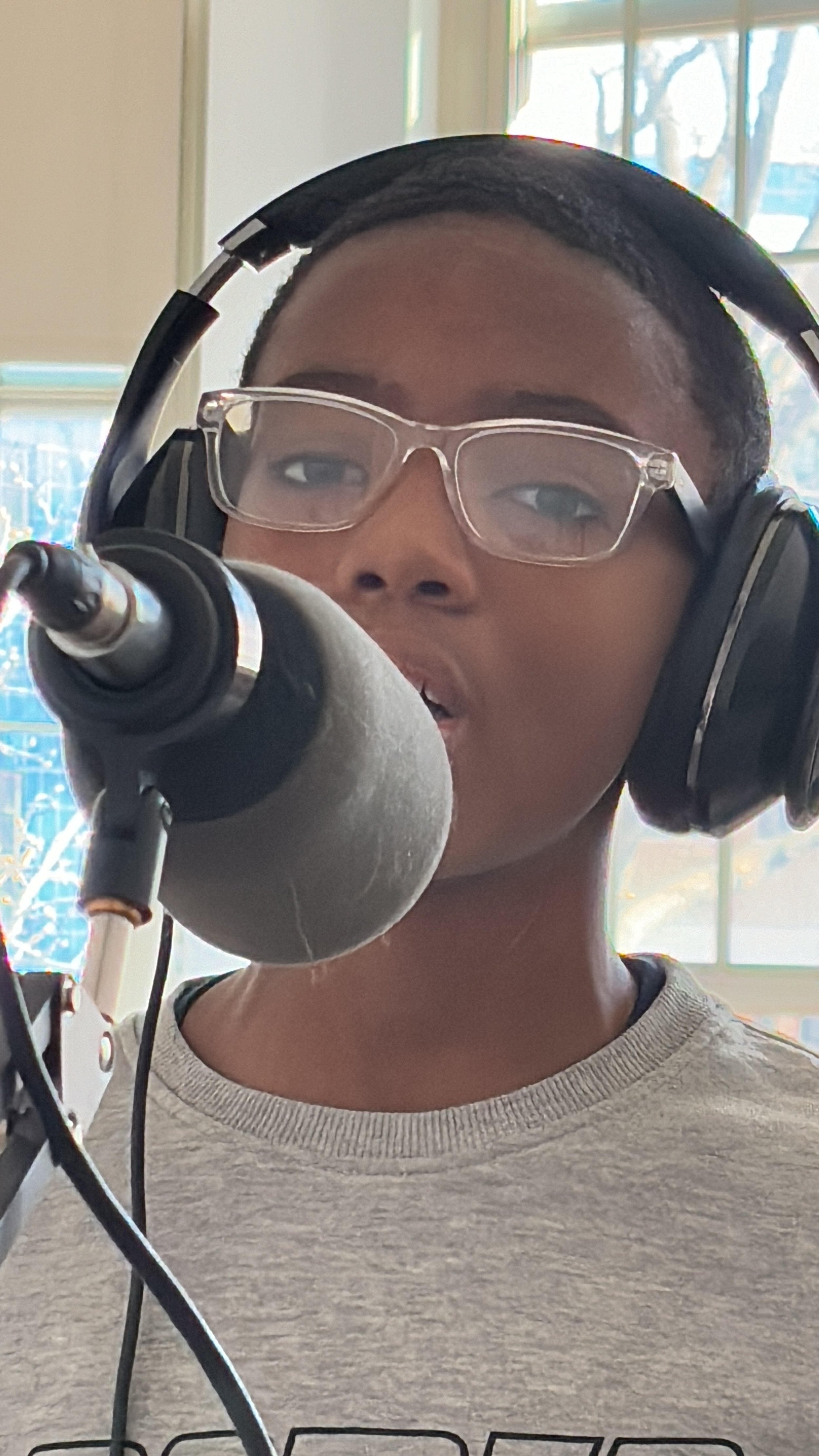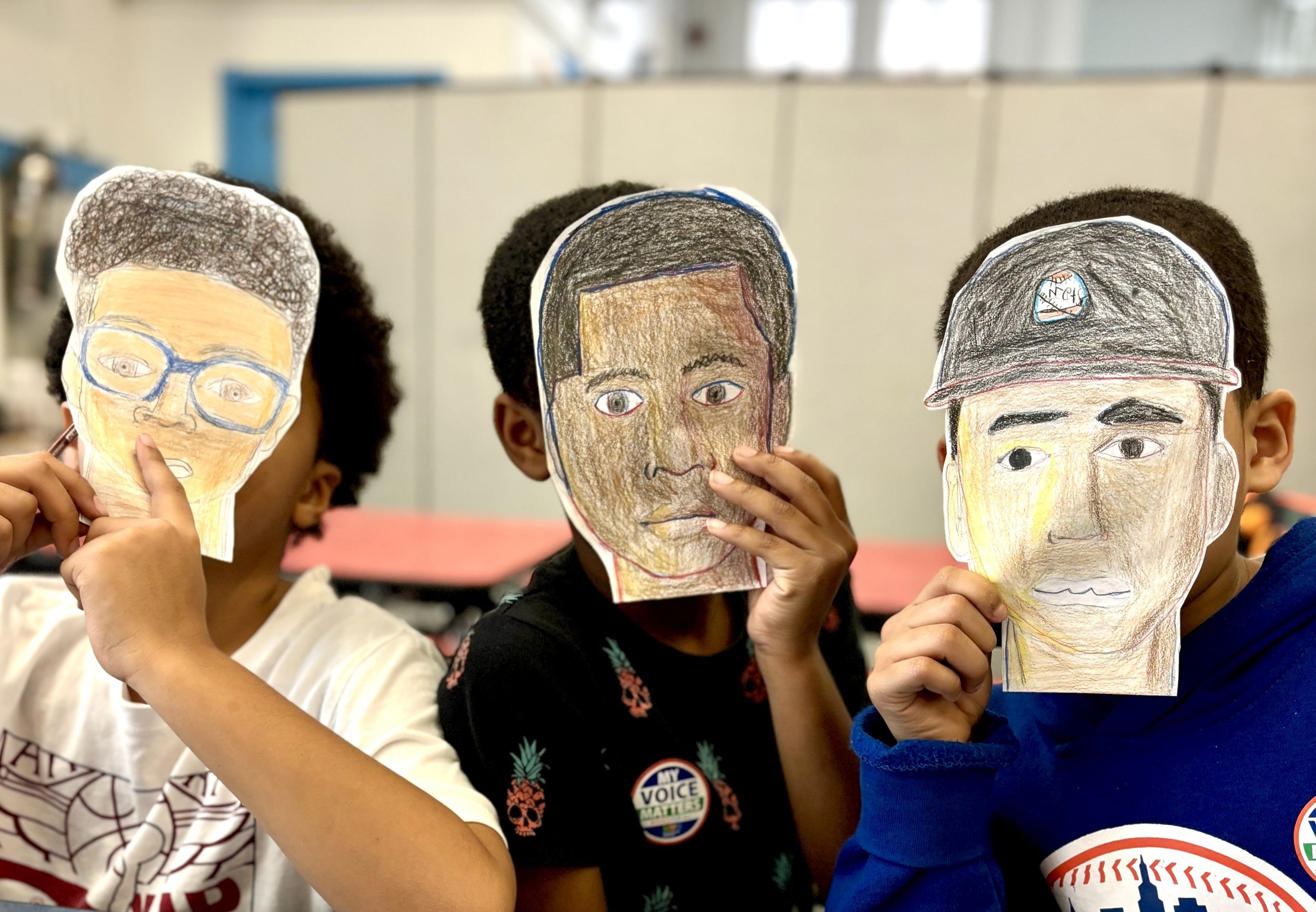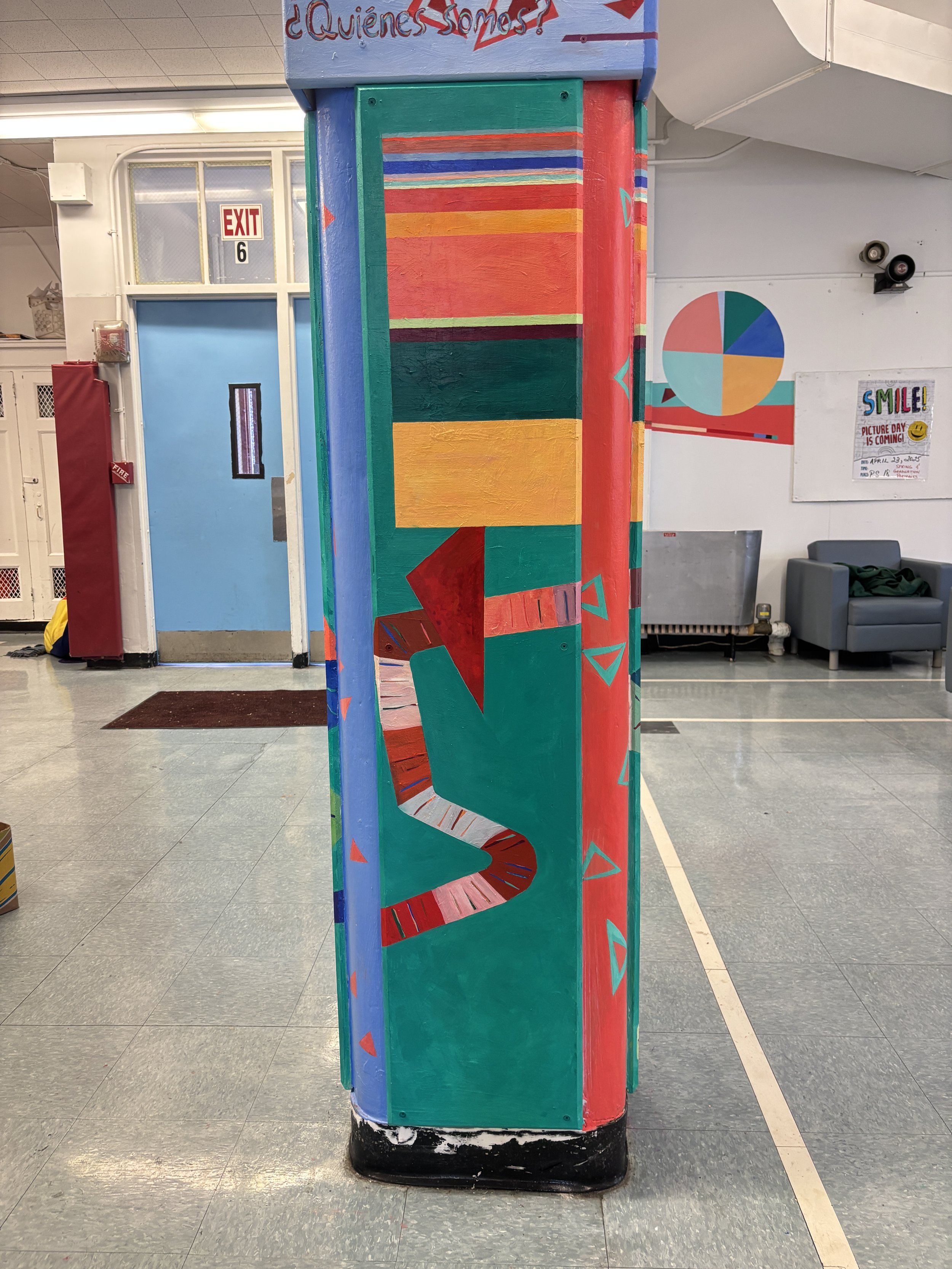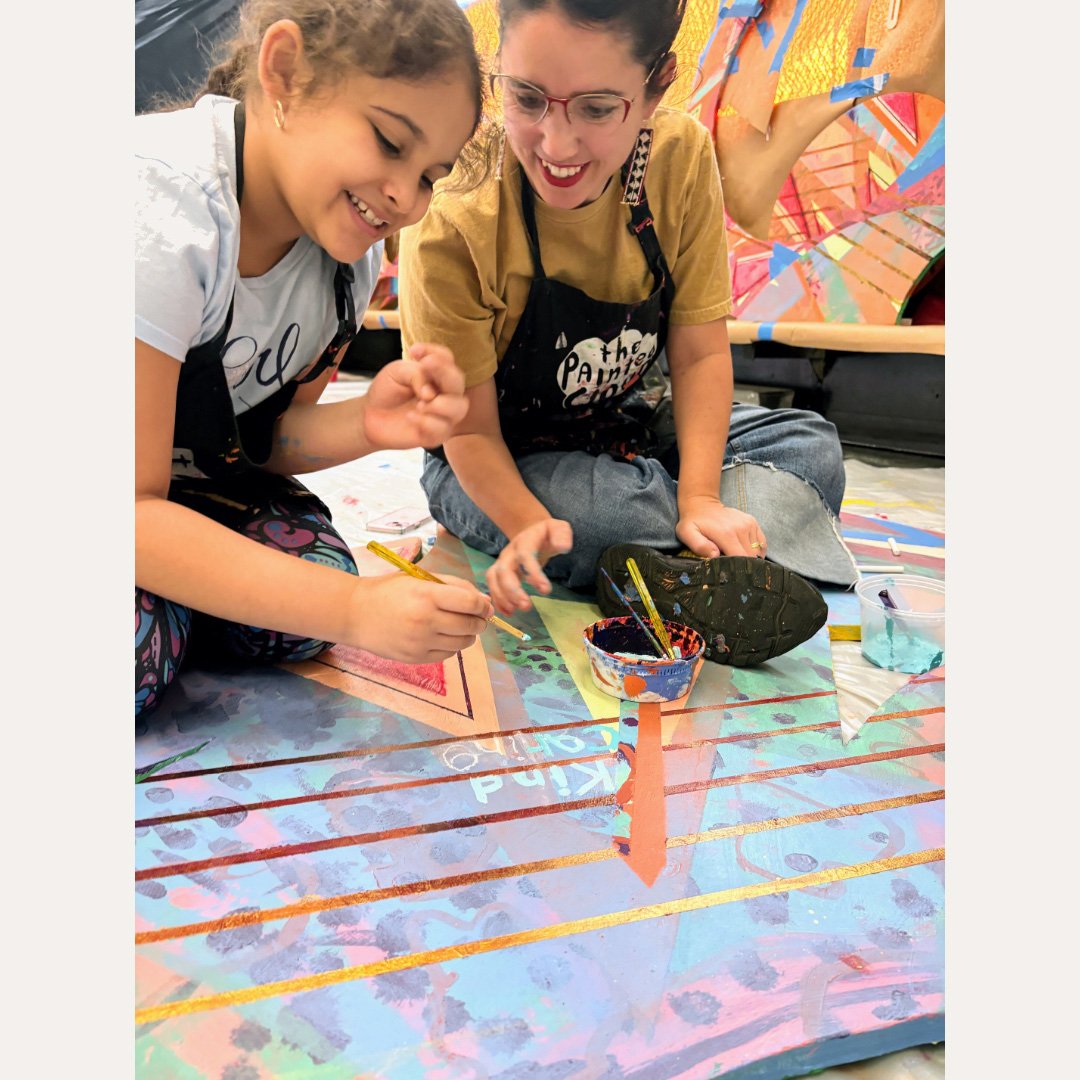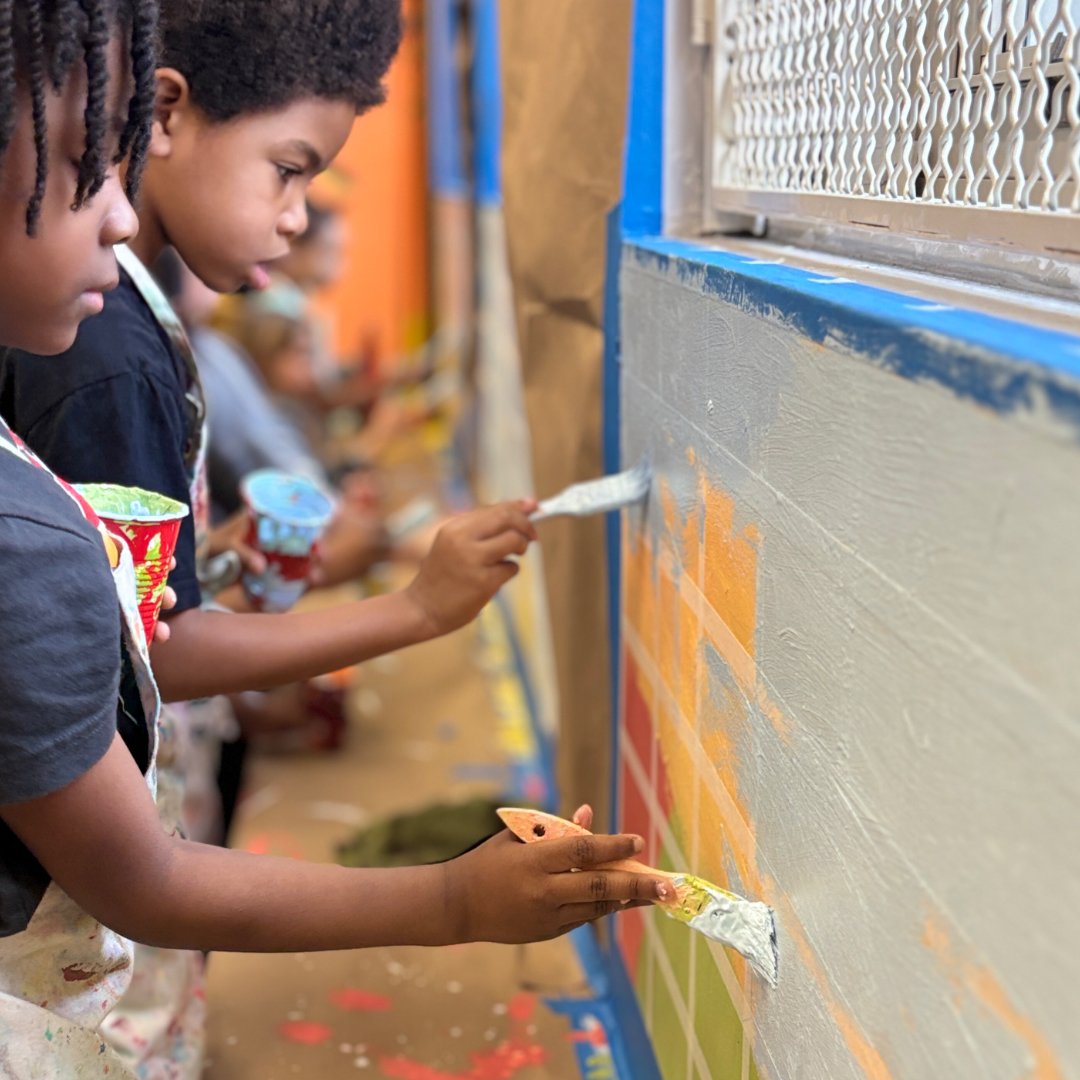You and Me / Me and You
Tú y Yo / Yo y Tú
PS 018 Elementary School
Brooklyn, NY 2025
The Painted Cloud led a two-year, student-directed, caregiver-engaged residency at PS18 Multilingual Neighborhood School in Williamsburg,
proudly supported as a recipient of the New York City Public Schools Arts for Multilingual Learners grant.
Rooted in inclusive educational practices honoring students’ identities, emotional well-being, and lived experiences, the residency focused on the theme
“Our Independence Co-exists with Connection to Others.”
The project created four creative components: an original bilingual song (in English and Spanish), two murals (indoor and outdoor), self-portraits compiled into a book, and a two-part music video. The collaborative, interdisciplinary project fostered ‘Habits of Mind’ thinking dispositions through hands-on, inquiry-based learning and cultivated a space for the PS18 community to engage meaningfully, where artistic creation, academic inquiry, and cultural relevance intersected. From the outset, the residency emphasized the belief that authentic relationships drive meaningful learning and collective transformation. By prioritizing empowerment, inclusivity, and agency, the project promoted equal access to meaningful learning for all students, fostering a community where every voice mattered.
Every family and student from grades K–5 participated in the project, and, crucially, every component was co-created by students and caregivers, who held real agency in shaping the final look and feel of each project component. This sense of empowerment and active engagement lay at the heart of the project’s ethos.
Artists Sarah Conarro and Julian Bozeman of The Painted Cloud did not arrive with a pre-set vision; instead, they prioritized cultivating a deep sense of belonging among students and their families.
To ensure inclusivity and authenticity, they introduced a key accessible entry point into the project: Family Questionnaire. This multilingual tool invited caregivers to share playful yet heartfelt insights about their children and was offered in English, Spanish, and German, echoing the long-standing dual language Spanish program and the newer German program. Offering the questionnaire in languages spoken at home reduced language barriers and supported participation across linguistic and cultural differences.
Having individualized questionnaire responses to depict the community was not only fun—for example, shared terms of endearment in families’ home languages included "schatzi" (German), "queen" (English), and "mi chiquita" (Spanish)—but also became essential creative content, infusing The Painted Cloud’s frameworks for creating murals, songs, portraits, and music videos with lived experiences and cultural specificity, which increased both the authenticity and relevance of the work.
The intention behind the project was to extend learning beyond academic content by affirming who students are within their cultural, emotional, and linguistic contexts.
By centering the voices of caregivers, the project nurtured identity development, belonging, and empowerment, inviting students to view their families’ voices as an integral part of their education. This approach expanded learning to include relationship-building, cultural intelligence, and social awareness, reinforcing students’ confidence and connection to one another.
Professional Development
The Painted Cloud also collaborated with classroom teachers and school administrators through professional development exchanges, creating space for active engagement and mutual learning. These exchanges allowed educators to share insights about the PS18 community and align academic content with core vocabulary.
Educators also participated in experiential learning activities, such as experimenting with a green screen or creating a collaborative drawing from smaller individual works—mirroring the hands-on, exploratory processes their students experienced.
During these activities, The Painted Cloud demonstrated multilingual and arts education practices, including co-teaching with educators in Spanish to model peer-to-peer learning. By participating, educators linked their own experiences to those of their students, deepening their understanding of the necessity and power of arts practices. Out of respect for educators' expertise and knowledge of their students’ needs, The Painted Cloud also gathered core content vocabulary to incorporate into the project, ensuring its responsiveness and relevance.
Original Song + Remix
The creation of the original song, You and Me / Me and You, invited students to engage in critical thinking and collaborative meaning-making.
Students read Family Questionnaire responses to the questions, “What is one positive trait that describes your child?” and “What is a term of endearment you say at home?”. They analyzed caregivers’ affirming responses to find multilingual rhymes and rhythms, and crafted lyrics that reflected the words their caregivers chose to describe them, cementing each student’s sense of belonging within the song.
Educators' input, including key vocabulary gathered from their insights, was also integrated into the lyric-writing process, further grounding the song in the community’s shared language. As they painted the mural, students practiced learning and singing their evolving song. Recording took place across the school—in classrooms, the cafeteria, and the library—using both a pop-up studio and field recorders.
For You and Me / Me and You, the project captured every student’s voice, creating a joyful, sonic record of collective belonging.
Multilingual learners then took the spotlight, working in small peer groups to translate and perform an all-Spanish version, Tú y Yo / Yo y Tú.
Throughout this process, multilingual learners took leadership roles, translating the song into Spanish and performing it alongside their peers, reinforcing their role as language experts and fostering a deeper connection to the PS18 community. The repetition of the song’s lyrics in both languages reinforced a sense of achievement for all students, regardless of which language they spoke.
Murals (outdoor + indoor)
The subjects of each mural centered on telling the story of the PS18 community in abstract shapes, lines, and graphs, exemplifying the real agency students had in shaping the final look of the artwork.
One mural featured lyrics from the song, while the other translated Family Questionnaire responses into vibrant graphs and charts.
The relevance of these visuals deeply invested students in the process, offering them a framework to experiment with painting in an abstract, collaborative context. This abstraction allowed students to scaffold both their technical and social skills: as they practiced using the brush to create a variety of lines and textures, they also learned to communicate with those around them. They developed an awareness of what had been painted before them and learned to contribute to the mural without covering up another’s work, as they wouldn’t want their own contributions to be erased. When they returned for subsequent painting sessions, students saw how their work had been added to, yet not covered up, demonstrating how their fellow students were being responsive and respectful to the evolving collective vision. In the process, multilingual learners played a key role by leading the peers in teaching important vocabulary related to painting and artistic materials, such as pincel (paint brush) and colores (colors).
Through this creative journey, students had the opportunity to develop their craft as they engaged and persisted in the work. As they worked together, they were encouraged to observe, reflect, and envision their ideas in new ways, while also being challenged to stretch and explore their skills and creativity.
The murals captured both community traits and culture through written words and visual data, directly echoing the project’s theme of “Our Independence Co-exists with Connection to Others.” They served as powerful public affirmations of inclusion, agency, and shared identity, highlighting the dynamic interplay between individuality and collective experience.
Colored Pencil + Watercolor Self Portraits
To balance the collaborative nature of mural-making, each student created an individual self-portrait as a personal exploration of identity. This process spanned multiple sessions, requiring students to return to their work with persistence and sustained focus, demonstrating the perseverance and self-management needed to improve their skills over time.
Using individual mirrors, students observed and carefully examined their own features, taking the time to notice the subtle details of their faces. Drawing from life, they had to be calm and deliberate, carefully selecting lines and colors to represent their likeness. This process encouraged risk-taking—embracing the possibility of mistakes while striving for accuracy. The challenge was not only in capturing their features but also in being open to changing and refining their drawings as they worked through each iteration. These full-color portraits, developed through lessons in life drawing, watercolor painting, and colored pencil shading, were compiled into a school-wide coffee table book.
In addition, students participated in a micro-writing exercise, adding affirmations like “I am curious” and “I am persistent,” which echoed personal insights from family members. The book also featured visual data—graphs and pie charts—based on Family Questionnaire responses, illustrating common traits and cultural themes across the school, and underscoring both individuality and shared experience. Together, the portraits and data affirmed each student’s unique identity while celebrating the collective strength and diversity of PS18, reinforcing that every child belongs and that their background, language, and culture are essential to the school’s collective narrative.
Two-Part Music Video
The residency culminated in the production of a two-part music video—one for the English version and one for the Spanish version of the song.
Filmed throughout the school, the video captured moments of laughter, movement, creativity, and pride. Students were not just the subjects of the videos—they were the creators, developing media literacy through hands-on engagement with DSLR cameras, HD video, and green screen technology, while also sharpening higher-order thinking skills. The process of playing with video and green screen invited a sense of humor, encouraging students to laugh at themselves and explore the unexpected moments that arose as they experimented with the technology. Humor became a way to navigate the social dynamics of collaboration, helping students develop an understanding of how to build relationships and lighten the atmosphere while respecting boundaries and creating a positive environment. In addition to honing their creativity, students asked questions about the new tools they were using, from adjusting camera settings to learning how to zoom in for a more focused shot.
Part one of the music video featured all students, while part two highlighted the multilingual learners of PS18, showcasing their faces, poses, and dance moves.
This shift in focus was powerful for these students, as the spotlight was on them in a way that highlighted their strengths, rather than reinforcing academic gaps. It was an essential part of the equity process, empowering these students by placing them at the center of the narrative, with their strengths and voices visible in every frame.
Celebration
Each year of the residency concluded with a school-wide celebration featuring screenings of the music videos and the unveiling of the collaborative murals, with families and caregivers joining to witness and celebrate the students’ work.
Students proudly led the singing of the songs, guiding their peers with confidence and joy. Many students sang along enthusiastically—some even breaking into spontaneous dance as the final chorus played. These joyful moments reflected not just artistic achievement, but a deep sense of connection, empowerment, and belonging.
Shared links to the songs and videos, along with take-home self-portraits, extended the impact of the project beyond the classroom—carrying the spirit of inclusion into homes and neighborhoods.
Graphs
One mural featured lyrics from the song, while the other translated Family Questionnaire responses into vibrant graphs and charts. The relevance of these visuals deeply invested students in the process, offering them a framework to experiment with painting in an abstract, collaborative context.
Creating Space for Every Voice
Throughout the residency, The Painted Cloud demonstrated how inclusive, culturally relevant arts education can foster belonging, deepen relationships, and activate student empowerment. By encouraging students to bring their full selves into the learning process, the project connected academic content to their lives in meaningful and transformative ways.
In both collaborative and individual processes, The Painted Cloud integrated reflection activities—drawn, written, or oral—that deepened students' understanding of each other’s lived experiences and cultures.
The project also modeled how equitable access to creative expression can support critical thinking and collaborative problem-solving, giving all students the opportunity to shine—and contribute to building a more just, compassionate, and inclusive world.
The four creative components—murals, bilingual songs, self-portraits, and the music video—worked in tandem, offering different avenues for student expression and community engagement.
By incorporating both collaborative and individual processes, the project provided a diverse range of learning opportunities, allowing students to shine in different ways. For example, the murals offered students a chance to explore large-scale, collaborative painting and develop their artistic skills, while the songs encouraged creative expression through language, rhythm, and performance. The self-portraits provided a personal outlet for identity exploration, while the music videos allowed students to be both the creators and the subjects, developing media literacy and higher-order thinking skills.
These various creative outlets catered to different learning styles and interests, supporting differentiated teaching methods and enabling each student to find their own voice. Some students thrived in the visual arts, others in language-based expression, while some excelled behind the camera or microphone. Each component was intentionally designed to provide unique moments for students to connect with their learning in ways that felt meaningful to students, all while contributing to a cohesive, collective project. By offering multiple outlets for student engagement, the project recognized the value of each student’s strengths and empowered them to contribute in a way that resonated with their individual abilities.
The final celebration—a screening of the music videos and mural unveiling—marked the close of the residency but not the end of its impact. The murals remain visible throughout the school, reinforcing the project’s central theme each day: “Our Independence Co-exists with Connection to Others”. Meanwhile, self-portraits traveled home, and song and music video links were shared (and can forever be shared) with families and friends, extending the spirit of inclusion and community far beyond the school walls.
At its core, You and Me / Me and You || Tú y Yo / Yo y Tú was about more than just making art—it was a bold act of collective empowerment, uncovering potential, and celebrating students' cultural and neighborhood knowledge. It affirmed that multilingualism and multiculturalism are gifts to be embraced. It affirmed that through dialogue, collaborative creation, and sustained engagement, a heightened understanding of the connections within the PS18 community could be achieved. By providing students with the tools, relationships, and confidence to embrace both their individuality and their place within the community, the project allowed them to see themselves in the curriculum, excel in it, and recognize their vital role in building a better world.


